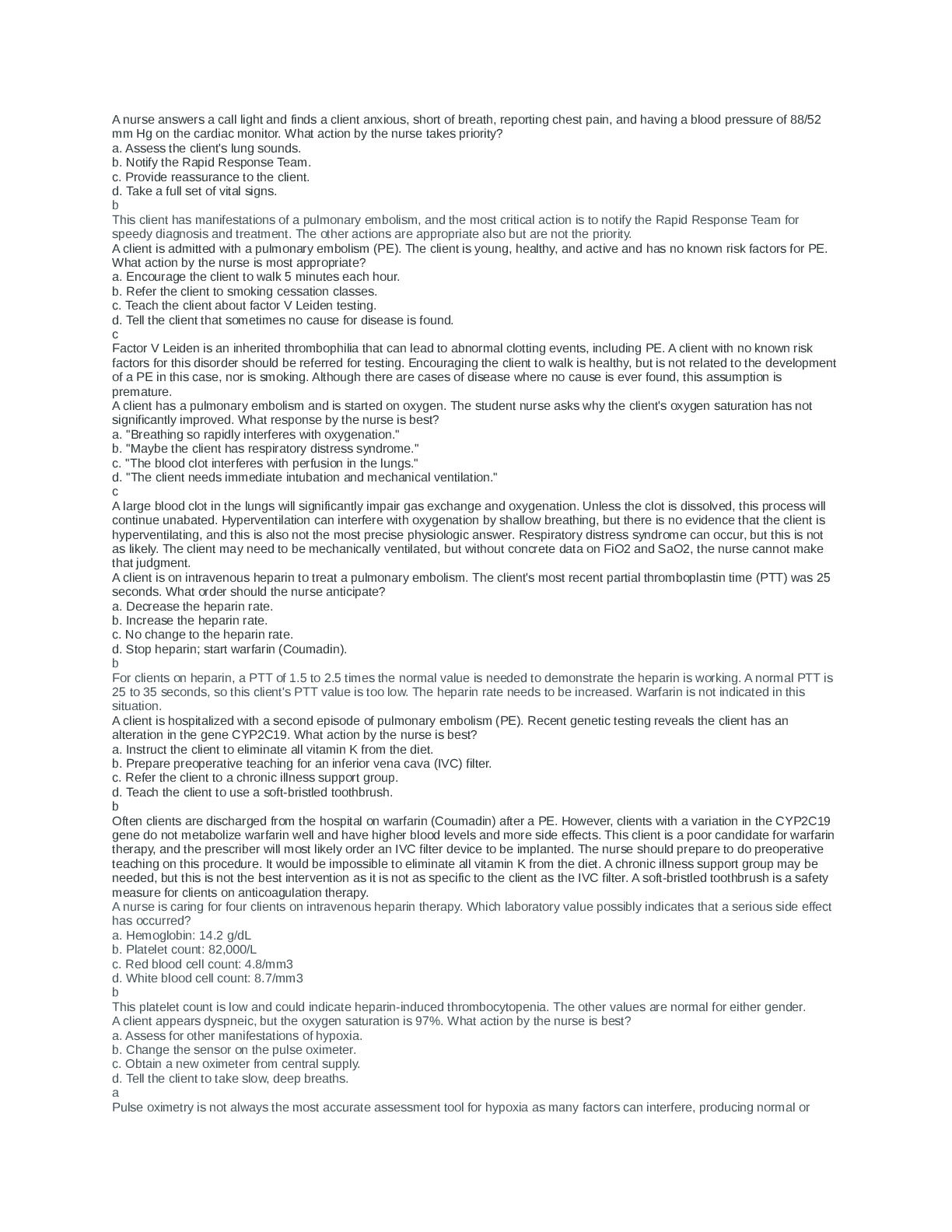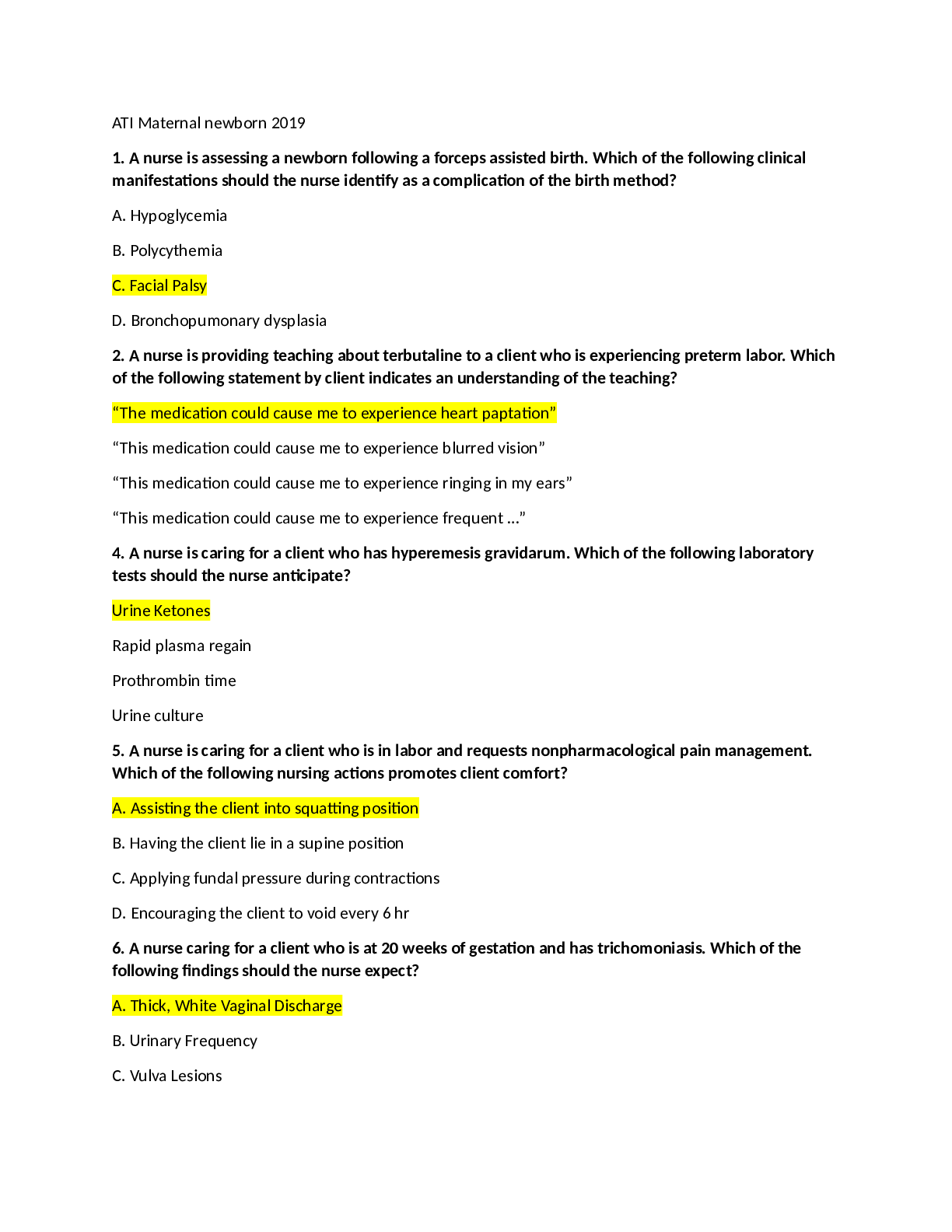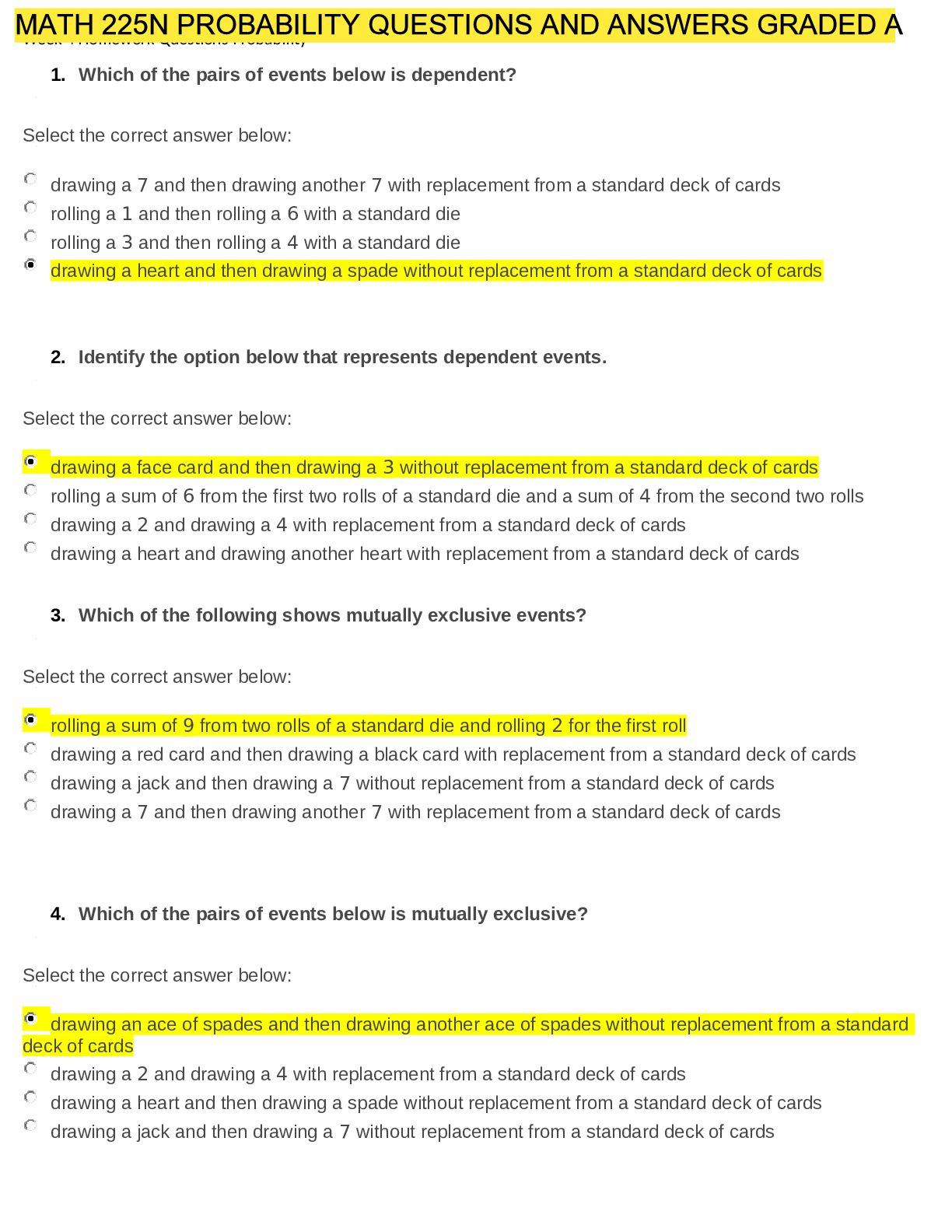*NURSING > QUESTIONS & ANSWERS > NURSING 2765 COMPLETE QUESTIONS AND ANSWERS 100% VERIFIED. (All)
NURSING 2765 COMPLETE QUESTIONS AND ANSWERS 100% VERIFIED.
Document Content and Description Below
NURSING 2765 COMPLETE QUESTIONS AND ANSWERS 100% VERIFIED. A nurse answers a call light and finds a client anxious, short of breath, reporting chest pain, and having a blood pressure of 88/52 mm ... Hg on the cardiac monitor. What action by the nurse takes priority? a. Assess the client's lung sounds. b. Notify the Rapid Response Team. c. Provide reassurance to the client. d. Take a full set of vital signs. b This client has manifestations of a pulmonary embolism, and the most critical action is to notify the Rapid Response Team for speedy diagnosis and treatment. The other actions are appropriate also but are not the priority. A client is admitted with a pulmonary embolism (PE). The client is young, healthy, and active and has no known risk factors for PE. What action by the nurse is most appropriate? a. Encourage the client to walk 5 minutes each hour. b. Refer the client to smoking cessation classes. c. Teach the client about factor V Leiden testing. d. Tell the client that sometimes no cause for disease is found. c Factor V Leiden is an inherited thrombophilia that can lead to abnormal clotting events, including PE. A client with no known risk factors for this disorder should be referred for testing. Encouraging the client to walk is healthy, but is not related to the development of a PE in this case, nor is smoking. Although there are cases of disease where no cause is ever found, this assumption is premature. A client has a pulmonary embolism and is started on oxygen. The student nurse asks why the client's oxygen saturation has not significantly improved. What response by the nurse is best? a. "Breathing so rapidly interferes with oxygenation." b. "Maybe the client has respiratory distress syndrome." c. "The blood clot interferes with perfusion in the lungs." d. "The client needs immediate intubation and mechanical ventilation." c A large blood clot in the lungs will significantly impair gas exchange and oxygenation. Unless the clot is dissolved, this process will continue unabated. Hyperventilation can interfere with oxygenation by shallow breathing, but there is no evidence that the client is hyperventilating, and this is also not the most precise physiologic answer. Respiratory distress syndrome can occur, but this is not as likely. The client may need to be mechanically ventilated, but without concrete data on FiO2 and SaO2, the nurse cannot make that judgment. A client is on intravenous heparin to treat a pulmonary embolism. The client's most recent partial thromboplastin time (PTT) was 25 seconds. What order should the nurse anticipate? a. Decrease the heparin rate. b. Increase the heparin rate. c. No change to the heparin rate. d. Stop heparin; start warfarin (Coumadin). b For clients on heparin, a PTT of 1.5 to 2.5 times the normal value is needed to demonstrate the heparin is working. A normal PTT is 25 to 35 seconds, so this client's PTT value is too low. The heparin rate needs to be increased. Warfarin is not indicated in this situation. A client is hospitalized with a second episode of pulmonary embolism (PE). Recent genetic testing reveals the client has an alteration in the gene CYP2C19. What action by the nurse is best? a. Instruct the client to eliminate all vitamin K from the diet. b. Prepare preoperative teaching for an inferior vena cava (IVC) filter. c. Refer the client to a chronic illness support group. d. Teach the client to use a soft-bristled toothbrush. b Often clients are discharged from the hospital on warfarin (Coumadin) after a PE. However, clients with a variation in the CYP2C19 gene do not metabolize warfarin well and have higher blood levels and more side effects. This client is a poor candidate for warfarin therapy, and the prescriber will most likely order an IVC filter device to be implanted. The nurse should prepare to do preoperative teaching on this procedure. It would be impossible to eliminate all vitamin K from the diet. A chronic illness support group may be needed, but this is not the best intervention as it is not as specific to the client as the IVC filter. A soft-bristled toothbrush is a safety measure for clients on anticoagulation therapy. A nurse is caring for four clients on intravenous heparin therapy. Which laboratory value possibly indicates that a serious side effect has occurred? a. Hemoglobin: 14.2 g/dL b. Platelet count: 82,000/L c. Red blood cell count: 4.8/mm3 d. White blood cell count: 8.7/mm3 b This platelet count is low and could indicate heparin-induced thrombocytopenia. The other values are normal for either gender. A client appears dyspneic, but the oxygen saturation is 97%. What action by the nurse is best? a. Assess for other manifestations of hypoxia. b. Change the sensor on the pulse oximeter. c. Obtain a new oximeter from central supply. d. Tell the client to take slow, deep breaths. a Pulse oximetry is not always the most accurate assessment tool for hypoxia as many factors can interfere, producing normal or [Show More]
Last updated: 2 years ago
Preview 1 out of 22 pages

Buy this document to get the full access instantly
Instant Download Access after purchase
Buy NowInstant download
We Accept:

Reviews( 0 )
$12.00
Can't find what you want? Try our AI powered Search
Document information
Connected school, study & course
About the document
Uploaded On
Mar 31, 2021
Number of pages
22
Written in
Additional information
This document has been written for:
Uploaded
Mar 31, 2021
Downloads
0
Views
89

.png)















.png)


.png)





